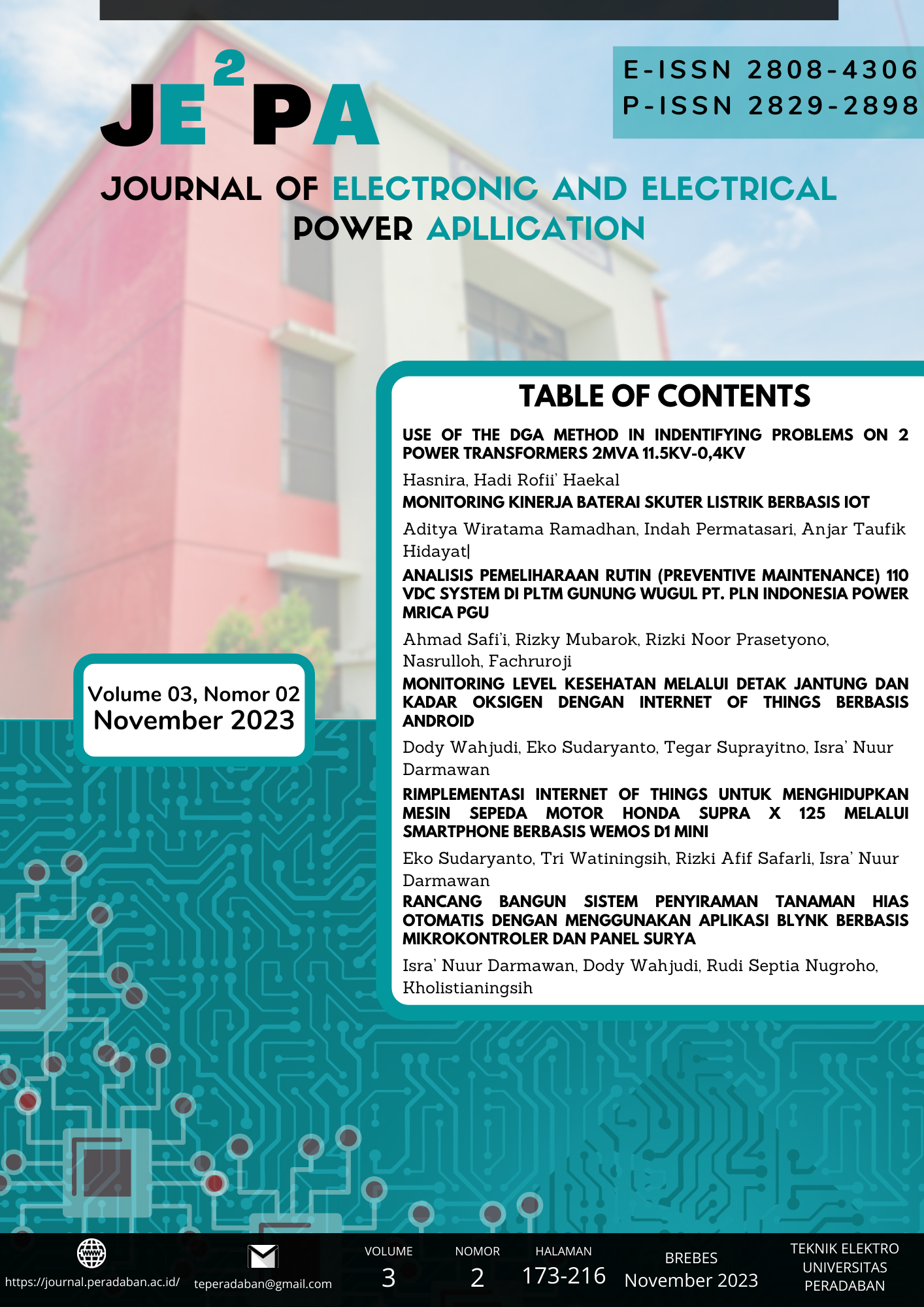INTERNET OF THINGS BASED BATTERY PERFORMANCE MONITORING ON ELECTRIC SCOOTERS
DOI:
https://doi.org/10.58436/jeepa.v3i2.1662Keywords:
Arduino, Baterai, Blynk, IoT, Skuter Listrik, SuhuAbstract
Batteries in electric vehicles, especially scooters, are very important to monitor to avoid the danger of overheating or to maintain battery life. In order for an electric scooter to run, a source of electrical energy is stored in a battery that is flexible and efficient. Batteries have the property of converting chemical energy into electrical energy, so it is necessary to carefully monitor their capacity. This can be done by monitoring several important parameters, namely: voltage, current, temperature on an electric bicycle. On electric scooters, it is necessary to take regular battery indicator readings. In this research, temperature sensor and voltage sensor are connected to Arduino. Arduino then sends data from the two sensors to the Blynk application via an internet connection. Users can access this data from the Blynk application on their smartphone and monitor battery performance on the electric scooter. Data sent from Arduino to the Blynk application can be used to monitor battery conditions on electric scooters in real-time and assist users in making decisions regarding the use of electric scooters. Through the test results obtained an average value of power on the battery of 71,46 W at a speed of 10 km/hour, at a speed of 20 km/hour the average value obtained was 79,34 W, and at a speed of 30 km/hour the average value the average power obtained is 87,62 W. So, the higher the vehicle speed, the higher the required battery performance.
References
Lenton, Timothy M., et al. "Quantifying the human cost of global warming." Nature Sustainability (2023): 1-11.
Helbling, Marc, and Daniel Meierrieks. "Global warming and urbanization." Journal of Population Economics 36.3 (2023): 1187-1223.
M. A. Adi Sutopo, Mustamam, “Analisis Gangguan Kualitas Daya Sistem Tenaga Listrik Di Universitas Negeri Medan,” J. Pendidik. Teknol. dan Kejuru., vol. 20, no. 1, pp. 1–2, 2018.
Xavier Nugraha, L. Srihandayani, and K. Goutama, “Analisis Skuter LIstrik Sebagai Kendaraan di Indonesia : Sebuah Tinjauan Hukum Normatif,” vol. 27, no. 2, pp. 118–141, 2020, doi: 10.28946/sc.v27i2.1041.
Syarifudin, Shofi, Rizky Mubarok, and Edmud Ucok Armin. "Design And Development Of Temperature And Feed Monitoring System On Chicken Cool Based On Internet Of Things Using Nodemcu ESP8266.: Array." Journal of Electronic and Electrical Power Applications 1.2 (2021): 29-35.
K. Baterai Sebagai, M. Nasution, and K. Kunci, “Karakteristik Baterai Sebagai Penyimpan Energi Listrik Secara Spesifik,” JET (Journal Electr. Technol., vol. 6, no. 1, pp. 35–40, 2021, [Online]. Available: https://jurnal.uisu.ac.id/index.php/jet/article/view/3797.
F. Susanto, N. Komang Prasiani, and P. Darmawan, “Implementasi Internet Of Things Dalam Kehidupan Sehari-Hari,” J. IMAGINE, vol. 2, no. 1, pp. 2776–9836, 2022, [Online]. Available: https://jurnal.std-bali.ac.id/index.php/imagine.
M. F. Sugianto, “Monitoring Kapasitas Baterai dan Kecepatan Laju Skuter Listrik Berbasis Android,” ALINIER J. Artif. Intell. Appl., vol. 2, no. 1, pp. 1–13, 2021, doi: 10.36040/alinier.v2i1.3267.
Presetya and R. Alfaiz, “Alat Monitoring Persentase Baterai dan Suhu Baterai Pada Sepeda Listrik Berbasis IoT AMOPEBASU : Alat Monitoring Persentase Baterai dan Suhu Baterai Pada Sepeda Listrik Berbasis IoT,” Univ. Islam Indones., no. 18524021, pp. 1–72, 2022.
R. Hardianto, “Monitoring dan Identifikasi Kerusakan Secara Realtime pada Motor BLDC dan Baterai Untuk Aplikasi Kendaraan Skuter Listrik,” pp. 60–61, 2019.
S. Budi, Joni, and H. Djiwo, “Rancang Bangun Sistem Kendali Sepeda Listrik Berbasis Arduino,” Pros. Semin. Nas. Teknol. Ind. Lingkung. dan Infrastruktur, vol. 2, p. 24, 2019, [Online]. Available: https://pro.unitri.ac.id/index.php/sentikuin.
D. Pangestu, F. Ardianto, and B. Alfaresi, “Sistem Monitoring Beban Listrik Berbasis Arduino Nodemcu Esp8266,” J. Ampere, vol. 4, no. 1, p. 187, 2019, doi: 10.31851/ampere.v4i1.2745.
Babiuch, Marek, Petr Foltýnek, and Pavel Smutný. "Using the ESP32 microcontroller for data processing." 2019 20th International Carpathian Control Conference (ICCC). IEEE, 2019.
Maier, Alexander, Andrew Sharp, and Yuriy Vagapov. "Comparative analysis and practical implementation of the ESP32 microcontroller module for the internet of things." 2017 Internet Technologies and Applications (ITA). IEEE, 2017.
Sari, Mona Berlian, et al. "Easy monitoring and data record system of electric current detected by ACS712 affordable non-destructive electrical current sensor." PILLAR OF PHYSICS 13.2 (2021).
Taif, Muhammad, M. Yunus Hi Abbas, and Moh Jamil. "Penggunaan Sensor Acs712 & Sensor Tegangan Untuk Pengukuran Jatuh Tegangan Tiga Fasa Berbasis Mikrokontroler Dan Modul Gsm/Gprs Shield." PROtek J. Ilm. Tek. Elektro 6.1 (2019).
Junizan, Nur Afiqah, et al. "Design and implementation of automatic room temperature controlled fan using Arduino Uno and LM35 heat sensor." International Journal of Engineering Creativity & Innovation 1.2 (2019): 8-14.
Hasan, Dathar, and Ayad Ismaeel. "Designing ECG monitoring healthcare system based on internet of things blynk application." Journal of applied science and technology trends 1.3 (2020): 106-111.
Rai, Pertab, and Murk Rehman. "ESP32 based smart surveillance system." 2019 2nd International Conference on Computing, Mathematics and Engineering Technologies (iCoMET). IEEE, 2019.
Alfita, Riza, et al. "Monitoring Kapasitas Baterai Dan Kecepatan Skuter Listrik Berbasis Android Dan Analisa Pengaruh Berat Badan Pengguna Terhadap Ketahanan Baterai." Jurnal Teknik Elektro dan Komputasi (ELKOM) 3.1 (2021): 43-52.
Nugroho, Agung, Randi Adzin Murdiantoro, and Nasrulloh Adzin Murdiantoro. "Design And Development Of A Leakage Current And Power Monitoring System With Nodemcu Esp 8266 For Household Electricity." JEEPA 3.1 (2023): 159-165.
Usuman, Ilona, and Hasmi Aardhi. "Sistem Pendeteksi Suhu Dan Asap Pada Ruangan Tertutup Memanfaatkan Sensor Lm35 Dan Sensor Af30." Berkala Fisika 13.2 (2010): 1-6.
Gunawan, Dedi. "Sistem Monitoring Distribusi Air Menggunakan Android Blynk." ITEJ (Information Technology Engineering Journals) 3.2 (2018): 28-36.
Syah, Muhammad Fakhrudin, and Yanu Shalahuddin. "Blynk Android App-Based System Smart Home Prototype." JTECS: Jurnal Sistem Telekomunikasi Elektronika Sistem Kontrol Power Sistem dan Komputer 2.2 (2022): 91-98.
Aristyo, Rastra Anggy. Rancang bangun sistem keamanan kendaraan bermotor berbasis iot dengan menggunakan modul nodemcu dan aplikasi android blynk. Diss. Universitas Islam Sultan Agung Semarang, 2021.
Hawa, S. D., Syauqi, A., Rolisnawati, R., & Za'im Akbar, H. (2023). Factor Analysis of Demand for Kaligua Tourism in Brebes Regency: A Case Study Using Primary Data. Media Trend, 18(1), 90-101.
Al Banin, Q., Eliyana, A., & Latifiyah, E. R. (2020). Enhancing employee performance with work motivation as a mediation variable. Systematic Reviews in Pharmacy, 11(9), 333-346.










